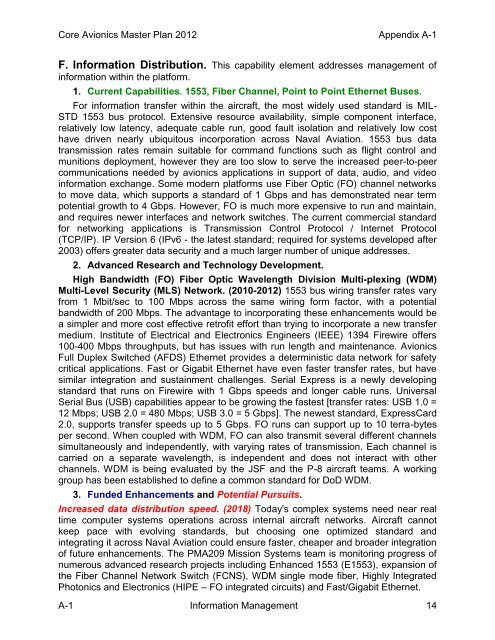PMA209 2012 Core Avionics Master Plan - NAVAIR - U.S. Navy
PMA209 2012 Core Avionics Master Plan - NAVAIR - U.S. Navy
PMA209 2012 Core Avionics Master Plan - NAVAIR - U.S. Navy
You also want an ePaper? Increase the reach of your titles
YUMPU automatically turns print PDFs into web optimized ePapers that Google loves.
<strong>Core</strong> <strong>Avionics</strong> <strong>Master</strong> <strong>Plan</strong> <strong>2012</strong> Appendix A-1F. Information Distribution. This capability element addresses management ofinformation within the platform.1. Current Capabilities. 1553, Fiber Channel, Point to Point Ethernet Buses.For information transfer within the aircraft, the most widely used standard is MIL-STD 1553 bus protocol. Extensive resource availability, simple component interface,relatively low latency, adequate cable run, good fault isolation and relatively low costhave driven nearly ubiquitous incorporation across Naval Aviation. 1553 bus datatransmission rates remain suitable for command functions such as flight control andmunitions deployment, however they are too slow to serve the increased peer-to-peercommunications needed by avionics applications in support of data, audio, and videoinformation exchange. Some modern platforms use Fiber Optic (FO) channel networksto move data, which supports a standard of 1 Gbps and has demonstrated near termpotential growth to 4 Gbps. However, FO is much more expensive to run and maintain,and requires newer interfaces and network switches. The current commercial standardfor networking applications is Transmission Control Protocol / Internet Protocol(TCP/IP). IP Version 6 (IPv6 - the latest standard; required for systems developed after2003) offers greater data security and a much larger number of unique addresses.2. Advanced Research and Technology Development.High Bandwidth (FO) Fiber Optic Wavelength Division Multi-plexing (WDM)Multi-Level Security (MLS) Network. (2010-<strong>2012</strong>) 1553 bus wiring transfer rates varyfrom 1 Mbit/sec to 100 Mbps across the same wiring form factor, with a potentialbandwidth of 200 Mbps. The advantage to incorporating these enhancements would bea simpler and more cost effective retrofit effort than trying to incorporate a new transfermedium. Institute of Electrical and Electronics Engineers (IEEE) 1394 Firewire offers100-400 Mbps throughputs, but has issues with run length and maintenance. <strong>Avionics</strong>Full Duplex Switched (AFDS) Ethernet provides a deterministic data network for safetycritical applications. Fast or Gigabit Ethernet have even faster transfer rates, but havesimilar integration and sustainment challenges. Serial Express is a newly developingstandard that runs on Firewire with 1 Gbps speeds and longer cable runs. UniversalSerial Bus (USB) capabilities appear to be growing the fastest [transfer rates: USB 1.0 =12 Mbps; USB 2.0 = 480 Mbps; USB 3.0 = 5 Gbps]. The newest standard, ExpressCard2.0, supports transfer speeds up to 5 Gbps. FO runs can support up to 10 terra-bytesper second. When coupled with WDM, FO can also transmit several different channelssimultaneously and independently, with varying rates of transmission. Each channel iscarried on a separate wavelength, is independent and does not interact with otherchannels. WDM is being evaluated by the JSF and the P-8 aircraft teams. A workinggroup has been established to define a common standard for DoD WDM.3. Funded Enhancements and Potential Pursuits.Increased data distribution speed. (2018) Today's complex systems need near realtime computer systems operations across internal aircraft networks. Aircraft cannotkeep pace with evolving standards, but choosing one optimized standard andintegrating it across Naval Aviation could ensure faster, cheaper and broader integrationof future enhancements. The <strong>PMA209</strong> Mission Systems team is monitoring progress ofnumerous advanced research projects including Enhanced 1553 (E1553), expansion ofthe Fiber Channel Network Switch (FCNS), WDM single mode fiber, Highly IntegratedPhotonics and Electronics (HIPE – FO integrated circuits) and Fast/Gigabit Ethernet.A-1 Information Management 14

















